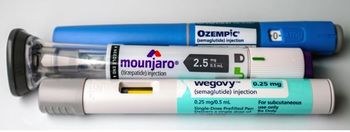
Osteoporosis in Men:
Prevention of and therapy for osteoporotic disorders in men have been virtually unexplored. Although osteoporosis in men is associated with significant morbidity and mortality, many clinical decisions must be based on extrapolation from data on osteoporosis in women.
Awareness of osteoporosis in men-especially elderly men-as an important health issue has increased, but current understanding remains limited and fragmentary. Prevention of and therapy for osteoporotic disorders in men have been virtually unexplored. Although osteoporosis in men is associated with significant morbidity and mortality, many clinical decisions must be based on extrapolation from data on osteoporosis in women.
In this article, I discuss the incidence and causes of osteoporosis in men and review current screening and treatment issues.
OVERVIEW
Osteoporosis is characterized by compromised bone strength that predisposes a person to an increased risk of fracture.1 In an effort to establish risk factors for fracture in postmenopausal white women, the World Health Organization (WHO) has defined osteoporosis on the basis of bone mineral density (BMD) testing, much as hypercholesterolemia is used to predict cardiac risk.2 Low BMD predicts fractures at least as well as high blood pressure predicts stroke.3 According to WHO criteria, normal BMD is within 1 standard deviation (SD) of the mean in normal young adults. Osteopenia (low BMD) is between 1 and 2.5 SD, and osteoporosis is 2.5 SD or more below this mean.2
The number of men with osteoporosis based on WHO-BMD criteria is unknown. If fracture is used as an indicator of osteoporosis, the lifetime risk for men is between 13% and 25%, compared with 50% for women.4 If the WHO criterion of 2.5 SD below peak bone mass is used, 1 to 2 million men probably have osteoporosis. However, this level of BMD may not signify the same fracture risk in men as in women, because men have greater peak bone mass and greater BMD than women throughout their lives.5 Some experts suggest that men sustain fractures at higher absolute BMD levels,6 and others believe that the same absolute value of BMD can be used as a cutoff in both men and women.7 Because of the lack of agreement on these issues, several reports warn that it is not clear how the WHO definition of osteoporosis can be applied in men.1,3
CAUSES AND CONSEQUENCES
Gradual loss of bone begins in both sexes between ages 30 and 40 years.1 Fracture rates are different in different countries8 and also vary by age and ethnicity. In persons younger than 55 years, the incidence of all types of fracture is higher among men. However, among those older than 55 years, the male:female incidence ratio is lower, and some sites show a marked female preponderance.
Risk factors for fracture in women that are thought to apply to men include inadequate levels of nutrition, exercise, and calcium and vitamin D intake.5 Variations in falls may explain the observed patterns of hip and Colles fractures. For example, when men fall, they may be less likely to fall on their hip than women.9 Also, men aged 50 to 64 years may be more likely than older men to fall sideways and less likely to fall forward.9 Older age, low body mass index, and low levels of physical activity probably increase fracture incidence because they are associated with low BMD, increased propensity to fall, and decreased ability to absorb fall impact.1
Osteoporotic hip and vertebral fractures are associated with significant morbidity and mortality. The incidence of hip fractures rises exponentially with age in men, but the age at which the increase begins is later (by 5 to 10 years) in men than in women.10 The probability that a 50-year-old man will have a hip fracture during his lifetime is 5% to 6% for a white man and 3% for an African American man. About 25% of men older than 60 years will experience an osteoporosis-related fracture in their remaining lifetime.11 Up to 30% of hip fractures and 20% of vertebral fractures occur in men.12
The serious consequences of osteoporosis in men are widely underappreciated. Mortality associated with hip fractures in men aged 75 years or older is approximately 30% higher than in women.10,13 Mortality is also higher in men following other types of fracture.14 Morbidity associated with hip fractures in men is substantial. In one study, 91% of men who experienced a hip fracture were aged 65 years or older. More than half of the men were subsequently discharged to nursing homes.15
WHO IS AT RISK?
Fracture. Focus history taking on risk factor assessment for osteoporotic fracture. According to the National Osteoporosis Foundation (NOF), the key risk factors for women are16:
- Personal history of fracture as an adult.
- History of fracture in a first-degree relative.
- Current cigarette smoking.
- Low body weight (less than 127 lb).
According to a recent meta-analysis, past cigarette smoking is a risk factor for low BMD.17 Current smokers have lower BMD than former or never smokers, but former smokers have lower BMD than never smokers. Smoking has an independent, dose-dependent effect on bone loss, which increases fracture risk. This may be partially reversed by smoking cessation.
Other risk factors for osteoporotic fracture include white race, advanced age, dementia, poor health/frailty, low calcium intake, alcoholism, impaired eyesight despite adequate correction, recurrent falls, and inadequate physical activity. These risk factors are independent of BMD.
A recent study lists the following risk factors for osteoporosis in men: hypogonadism, corticosteroid use, history of fragility fracture or hyperthyroidism, gastric surgery, hemiparesis, Parkinson disease, dementia, vertigo, alcoholism, and blindness.7
BMD is an independent predictor of mortality, especially for those older than 70 years. Low BMD is a stronger predictor of death than elevated blood pressure or cholesterol levels.18
Although alcoholism is considered a risk factor, moderate alcohol intake protected femoral neck BMD in a study of 220 men followed for 5 years.19 The lack of clear dose- response benefit in published reports serves to emphasize that further research is required to elucidate whether there is a threshold effect below which alcohol is actually protective-and also whether the relationship between alcohol and fractures is skewed by confounding factors.
Secondary osteoporosis. The secondary causes of osteoporosis are listed in Table 1. Rheumatoid arthritis and liver disease are often overlooked as risk factors for secondary osteoporosis (Box).16,20 Anticonvulsants, excessive use of thyroxine, and long-term use of anticoagulants16,21 and corticosteroids have been associated with the development of osteoporosis. Although data regarding iatrogenic and secondary causes are scarce in men, it is likely that these causes affect men as well as women.
Secondary causes of bone loss are believed to be more common in men than in postmenopausal women; they are responsible for 30% to 60% of cases of osteoporosis in men.1 The most common of these causes are hypogonadism, corticosteroid use, and alcoholism.
Although both men and women start to lose BMD in midlife, men are spared the rapid bone loss that characterizes early menopause. Testosterone production in adolescent boys and men is central to achievement and maintenance of maximum bone mass, and estrogens are necessary for the growth and maturation of the male skeleton. However, no randomized, controlled trials have shown that testosterone therapy decreases fracture risk in men, and testosterone replacement is generally recommended only in men with documented low circulating testosterone levels.1
SCREENING
The NIH Consensus Guidelines do not specify particular tests for secondary osteoporosis; however, they do recommend testing for secondary causes once osteoporosis is diagnosed.1 Although the NOF emphasizes primarily postmenopausal osteoporosis, their guidelines recommend "limited biochemical testing" (serum levels of thyroid-stimulating hormone, parathyroid hormone, vitamin D, urine calcium or cortisol, and protein electrophoresis) in some cases.16 Other guidelines do not offer specific testing algorithms,1,3,21 principally because a cost-effective approach to testing for secondary causes of osteoporosis has not yet been established.
Many clinicians check blood levels of thyroid-stimulating hormone, parathyroid hormone, 25-hydroxyvitamin D, liver function, renal function, free testosterone, and possibly urine calcium in men found to have low BMD. Decisions about further diagnostic testing are based on the patient's other risk factors and comorbid conditions. Some experts also recommend that bone biopsy be considered in men with osteoporosis to rule out unusual conditions, such as osteomalacia and mastocytosis, for which specific treatments are indicated. 5,10 Referral to a specialist is warranted in these cases.
It must be strongly emphasized that clinical risk factors-even if several exist-are not adequate predictors of osteoporosis or fracture risk. BMD is the single best predictor of fracture risk.22
BMD testing. The current standard test for BMD is dual-energy x-ray absorptiometry (DXA). Its advantages include ease of administration, low radiation exposure, speed, convenience of radiation source, and ability to measure sites of pivotal clinical importance (such as hip and spine).21
Universal BMD testing is not currently recommended. According to the AMA guidelines, the indications for DXA are11:
- Hypogonadism.
- Hyperthyroidism.
- Excessive alcohol consumption.
- Radiologic suspicion of osteoporosis.
- Corticosteroid therapy.
- Other known causes of secondary osteoporosis.
The preferred site for diagnostic assessment in elderly patients is the hip. This is because of the close relationship between hip BMD and the clinically devastating outcome of hip fractures, and also because of the possible artifacts in lumbar BMD assessment that are seen in elderly persons.3
Interpreting DXA results in men. A standard DXA report includes both lumbar spine and hip measurements. Bone loss may vary at different sites-especially in younger patients-because bones achieve peak mineral density at different times and lose mineral density at different rates.21 On occasion, lumbar spine DXA measurements are artificially increased by osteophytes from degenerative changes, paraspinal ligament calcification, aortic calcification, or existing vertebral compression fractures.
Hip and spine measurements are expressed as T- and Z-scores. The T-score compares BMD to the peak, normal, young adult mean drawn from the National Health and Nutrition Examination Survey reference database.4 The T-score is therefore the value used to make the diagnosis of osteoporosis by WHO criteria. The Z-score reflects how a patient's BMD compares with that of age- and sex-matched persons and is used for risk assessment.
PREVENTION AND TREATMENT
The NOF guidelines do not include men,and AMA guidelines did not until recently include them because of the paucity of information on risk factors for and treatment of osteoporosis in men.21
The most recent WHO report does not distinguish between osteoporosis and fracture prevention recommendations for men and women.3 A summary of the recommendations is given in Table 2.
Nondrug therapy. For men with osteoporosis, supplementation with calcium, 1200 to 1500 mg/d,23 and vitamin D, 600 IU/d,24 is recommended. Advise these patients to avoid cigarette smoking and increase weight-bearing exercise. Although it appears prudent to avoid excessive alcohol intake, the amount of alcohol considered "safe" for bone is not known.
Drug therapy. The antiresorptive agent alendronate, a bisphosphonate indicated for the prevention and treat-ment of osteoporosis in postmenopausal women, has also been approved for use in increasing low BMD in men but not for the treatment of established osteoporotic fractures per se. In an important placebo-controlled, randomized, controlled trial, alendronate, 10 mg/d, was administered to men with osteoporosis.25 Treatment with alendronate was associated with increases in BMD, a reduced incidence of new vertebral fracture, and reduced height loss. Alendronate is also approved for corticosteroid-induced osteoporosis in men and women with low BMD who are taking prednisone, 7.5 mg/d (or the equivalent).
Risedronate, another bisphosphonate, has also been approved for corticosteroid-induced osteoporosis, but not for idiopathic or other types of osteoporosis in men.
Androgen replacement is appropriate only in the setting of documented low serum testosterone levels.5 Other potential treatments, such as parathyroid hormone and statins, are under investigation.
Recent guidelines are beginning to address the issues of prevention and treatment of osteoporosis in men.1,11Table 3 lists some key points of the recent AMA guidelines.11
FOLLOW-UP TESTING
Recent data point out several potentially important pitfalls of using serial BMD measurements to monitor men (or women) who are taking osteoporosis medication. Although there is a strong and reliable relationship between BMD and fracture risk in untreated patients, this relationship is not as strong among treated patients. Furthermore, the effects of antiresorptive therapies cannot be entirely explained by changes in BMD. Trials have not focused on the effectiveness of alternate treatments in patients considered nonresponders by serial BMD tests. Combination therapy has not been shown to be more effective than single-agent therapy in reducing fracture; hence, serial BMD testing cannot be used to help decide when to prescribe an additional agent.11
The role of serial BMD testing is a controversial and complex issue that has been reviewed elsewhere.26 No controlled clinical studies have shown that serial monitoring can influence treatment decision making and that changes in treatment result in improved patient outcomes.21
Apparent loss of BMD in women taking alendronate, raloxifene, or postmenopausal hormone replacement therapy is likely to convert to gain. Patients who gain large amounts of bone mass in the first year but lose bone mass in the second year of continued pharmacotherapy are not necessarily showing a lack of response to therapy, but rather may be showing that random error in baseline BMD change corrects itself later.27-29 To what extent these data might apply specifically to men is unknown.
FUTURE STRATEGIES
Our understanding of osteoporosis in men will be greatly enhanced by future clarification of the following issues:
- The appropriate BMD cutoff (or T-score) for diagnosis and treatment.
- The relationship between absolute levels of bone mass and fracture risk.10
- The use of bone turnover measurement or serial BMD testing in the management of men with osteoporosis who are being treated with antiresorptive agents.5
- The role of bone turnover marker assessment in clinical practice.3
Osteoporosis is an under-recognized disease in men that has potentially dire consequences. New treatments need to be tested in randomized, controlled trials and made available to clinicians and patients. Until research can augment our pharmacologic options, clinicians must continue to encourage men to optimize bone health throughout their lives by such measures as adequate calcium intake and weight-bearing exercise.1
- FOR MORE INFORMATION:
The American Medical Association has a continuingmedical education program on osteoporosis. Informationis available at:www.ama-assn.org/cme .Accessed July 16, 2002.
References:
- REFERENCES:1. Osteoporosis prevention, diagnosis, and therapy.JAMA. 2001;285:785-795.
2. Assessment of fracture risk and its application toscreening for postmenopausal osteoporosis: reportof a WHO Study Group. World Health Organ TechRep Ser. 1994;843:1-129.
3. Genant HK, Cooper C, Poor G, et al. Interim reportand recommendations of the World Health OrganizationTask-Force for Osteoporosis. OsteoporosInt. 1999;10:259-264.
4. Looker AC, Orwoll ES, Johnston CC Jr, et al. Prevalenceof low femoral bone density in older US adultsfrom NHANES III. J Bone Miner Res. 1997;12:1761-1768.
5. Bilezikian JP. Osteoporosis in men. J Clin EndocrinolMetab. 1999;84:3431-3434.
6. Selby PL, Davies M, Adams JE. Do men and womenfracture bones at similar bone densities? Osteoporos Int.2000;11:153-157.
7. Kanis JA. Diagnosis of osteoporosis and assessmentof fracture risk. Lancet. 2002;359:1929-1936.
8. Donaldson LJ, Cook A, Thomson RG. Incidenceof fractures in a geographically defined population.J Epidemiol Community Health. 1990;44:241-245.
9. O’Neill TW, Varlow J, Silman AJ, et al. Age andsex influences on fall characteristics. Ann RheumDis. 1994;53:773-775.
10. Orwoll ES. Osteoporosis in men. EndocrinolMetab Clin North Am. 1998;27:349-367.
11. American Medical Association. Managing Osteoporosis:Update in Patient Management. Chicago:American Medical Association; 2001.
12. Eastell R, Boyle IT, Compston J. Managementof male osteoporosis: report of the UK ConsensusGroup. QJM. 1988;91:71-92.
13. Davidson CW, Merrilees MJ, Wilkinson TJ, etal. Hip fracture mortality and morbidity: can we dobetter? N Z Med J. 2001;114:329-332.
14. Center JR, Nguyen TV, Schneider D, et al. Mortalityafter all major types of osteoporotic fracture in menand women: an observational study. Lancet. 1999;353:878-882.
15. Poor G, Atkinson EJ, Lewallen DG, et al. Agerelatedhip fractures in men: clinical spectrum andshort-term outcomes. Osteoporos Int. 1995;5:419-426.
16. National Osteoporosis Foundation. Physician’sGuide to Prevention and Treatment of Osteoporosis. Washington,DC: National Osteoporosis Foundation; 1998.
17. Ward KD, Klesges RC. A meta-analysis of theeffects of cigarette smoking on bone mineral density.Calcif Tissue Int. 2001;68:259-270.
18. Johansson C, Black D, Johnell O, et al. Bone mineraldensity is a predictor of survival. Calcif Tissue Int.1998;63:190-196.
19. Nguyen TV, Eisman JA, Kelly PJ, Sambrook PN.Risk factors for osteoporotic fractures in elderly men.Am J Epidemiol. 1996;144:255-263.
20. Eastell R. Treatment of postmenopausal osteoporosis.N Engl J Med. 1998;338:736-746.
21. American Medical Association. Managing Osteoporosis.Chicago: American Medical Association; 1999.
22. Consensus development conference: diagnosis,prophylaxis, and treatment of osteoporosis. Am JMed. 1993;94:646-650.
23. NIH Consensus Development Panel on OptimalCalcium Intake. Optimal calcium intake. JAMA.1994;272:1942-1948.
24. Institute of Medicine. Dietary Reference Intakes.Washington, DC: National Academy Press, Foodand Nutrition Board; 1998.
25. Orwoll E, Ettinger M, Weiss S, et al. Alendronatefor the treatment of osteoporosis in men. N Engl JMed. 2000;343:604-610.
26. Crandall C. The role of serial bone mineral densitytesting for osteoporosis. J Womens Health GendBased Med. 2001;10:887-895.
27. Cummings SR, Palermo L, Browner W, et al, forthe Fracture Intervention Trial Research Group. Monitoringosteoporosis therapy with bone densitometry:misleading changes and regression to the mean.JAMA. 2000;283:1318-1321.
28. Greendale GA, Wells B, Marcus R, Barrett-ConnorE. How many women lose bone mineral densitywhile taking hormone replacement therapy? Resultsfrom the Postmenopausal Estrogen/Progestin InterventionsTrial. Arch Intern Med. 2000;160:3065-3071.
29. Sarkar S, Mitlak BH, Wong M, et al. Relationshipsbetween bone mineral density and incident vertebralfracture risk with raloxifene therapy. J Bone Miner Res.2002;17:1-10.
30. Michel BA, Lane NE, Jones HH, et al. Plain radiographscan be useful in estimating lumbar bonedensity. J Rheumatol. 1990;17:528-531.
31. Garton MJ, Robertson EM, Gilbert FJ, et al. Canradiologists detect osteopenia on plain radiographs?Clin Radiol. 1994;49:118-122.
Newsletter
Enhance your clinical practice with the Patient Care newsletter, offering the latest evidence-based guidelines, diagnostic insights, and treatment strategies for primary care physicians.































































































































































































































































































